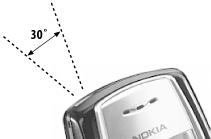Infrared Security
Unlike Bluetooth and 802.11, Infrared requires an unobstructed line of sight in order for two devices to communicate with each other. It also has a much smaller operating range, compared to the other two. For these reasons, Infrared does not provide any security mechanism at the link level; instead, applications must implement their own security measures at a higher protocol level.
To better understand the security risk of Infrared, let’s look at some characteristics of it. An infrared connection operates at a range of 0 to 1 meter, with peak intensity within a 30 degree cone (see Figure 7-26). With more power, a longer operating range is possible with a reduction in transfer speed. In addition, an infrared connection requires a visual line of sight (LOS) in order to work. In other words, there must be no direct obstruction between the two communicating devices.

Figure 7-26. The 30 degree cone for peak power intensity of an infrared port
Considering that infrared communications operate at such a short range, it is quite difficult for an attacker to eavesdrop without being noticed (or completely breaking the connection).
Get Windows XP Unwired now with the O’Reilly learning platform.
O’Reilly members experience books, live events, courses curated by job role, and more from O’Reilly and nearly 200 top publishers.

